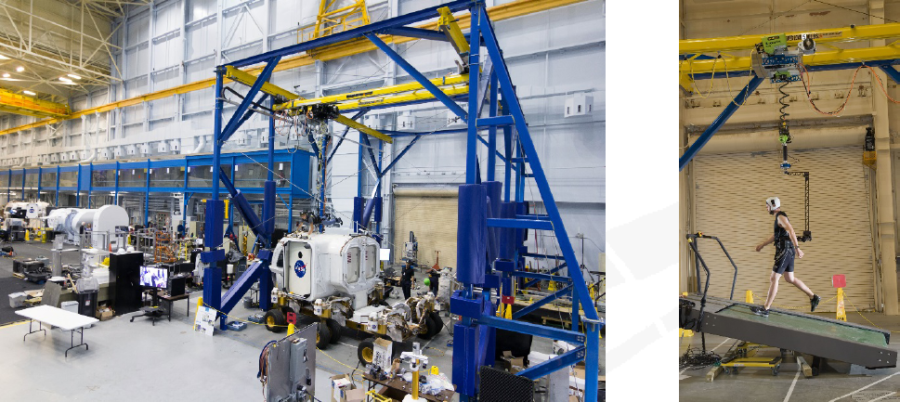Overview of NASA EVA Virtual Reality Training, Past, Present and Future.
Eddie Paddock/NASA/JSC Engineering
eddie.paddock@nasa.gov
Virtual Reality Lab (vrlab.jsc.nasa.gov, @vr_doug)
JSC’s Virtual Reality Lab

VR Lab (VRL)
Mission
- To provide a VR training facility, products and services to our Space Station Program and Flight Operations Directorate stakeholders in support of ISS EVA and Robotic operations including simulations, 3D graphics, immersive HMDs and tracking systems, mass handling and onboard VR training
- Augment Neutral Buoyancy Lab (NBL) astronaut EVA training
Location
- JSC, B9, room 2116, x42202
- vrlab.jsc.nasa.gov, @vr_doug
Current Team Members
- Eddie Paddock/NASA/ER7 –Simulation and Graphics Branch
- Brad Bell/CACI
- Jeff Hoblit/CACI
- Evelyn Miralles/CACI
- John Schweers/CACI
- Frankie Graffagnino/METECS
Neutral Buoyancy Lab (NBL)

VRL History
- 1991 –VR Lab was started by Dave Homan/ER7 : To augment NBL ISS/Shuttle EVA training
- 1993 –STS-61 Hubble repair, and mass handling training
- 1994 –Simplified Aid For EVA Rescue (SAFER)
- 1994 –Shuttle Robotics
- 2000 –ISS Robotics integrated with EVA/Shuttle Robotics
- 2001 –DOUG graphics onboard ISS
- 2004 –Shuttle tile surveying
- 2012 –VR training onboard ISS
- 2016 –Upgrading Charlotte Mass Handling Robot VR System
- 2016 –Using COTS HMDs, Wireless Tracking and Game Engines
- Oculus Rift and HTC Vive with Unity and Unreal4 game engines
- Port of DOUG graphics to Rift and Vive HMDs
VRL HMDs

VR EVA Training
Astronaut EVA (Extra-Vehicular Activity) Training
– Space walks for ISS sustaining including robotics ops
– SAFER (Simplified Aid For EVA Rescue)
– EVA Mass Handling
– VRT (Virtual Reality Trainer) -Onboard ISS

Robotics Workstation for MSS

Mass Handling Robot -Charlotte

Historical Training Statistics

Researching Commercial VR HMD Technologies
Oculus DK2, Rift
– HERA (next slide)
– Possible use for VRT onboard ISS

HTC Vive/Unreal4
– Hybrid Reality/ISS IVA Demo
– F. Delgado and M. Noyes/ER6

Virtual Reality EVA for HERA (Human Exploration Research Analogs)
- Multi-Mission Space Exploration Vehicle (MMSV) Itokawa asteroid simulation with VR EVA
- 2 crew EVA and 2 crew flying the MMSEV
- HERA is interested in team dynamics while the crew are under stress performing an exploration mission

VR & ARGOS
- Active Response Gravity Offload System (ARGOS)

- Integrating VR/AR/MR technologies with ARGOS to support EVA training, planetary surface mission development, hardware evaluations, tele-operation, and human performance/ergonomic studies for current and future NASA missions
- Investigating MR with “green screen” or chromakey techniques of using optics for tracking and mixing in real filtered video for avatar and physical bodies with virtual scenes
Views ISS VR Distributed Scenario with ARGOS

ARGOS Facility Demo

Mixed Reality –Green Screen Work

Use of VR for Orion
- Mini-Exercise Device (MED) Exercise Volume Study

Deep Space Gateway EVA

VR Future Work
- Integration of VR into ARGOS
- More use of COTS HMD Systems
- Virtual Reality Trainer (VRT) onboard ISS
- Augmented Reality Applications -HoloLense
- Tracking systems and Avatar imaging
- OptiTrackwith passive reflectors
- Lighthouse tracking
- Wireless tracking systems
- Hands and finger tracking
- Continue with Green Screen Mixed Reality Work
- Performance improvements
- ARGOS integration
- Habitat Design Evaluations for Deep Space Gateway
VR Topics
- Latest HMDs including wireless, high resolution displays, backpack solutions like HP’s Z VR backpack
- Room scale wireless passive and active tracking systems (Lighthouse, Optitrackand other more unique concepts like accelerometer suits), and integration with game engines and HMDs
- Inside-out onboard tracking systems
- Rendering Engine upgrades and plugins for better performance (Unity, Unreal4and performance upgrade packages like Nvidia’s Holodeck)
- Hand and finger tracking (Manus VR, Valve Knuckle’s controllers, etc.)
- High performance graphics cards and configuration options
- Distributed Host/client and state synchronization VR technologies
Read More About This Guide & Download PDF
Question About this Guide, Post in the Comment.
